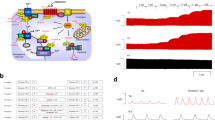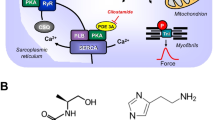Summary
The present study characterizes myocardial effects of two new histaminergic H2-receptor specific compounds, impromidine, and dimaprit, on cardiac contractile and metabolic parameters of the guinea pig heart and human papillary muscle in comparison to the well-known effects of catecholamines. Impromidine and dimaprit produced a dose-dependent stimulation of the right and left ventricular contractile force in the isolated perfused biventricular catheterized guinea pig heart with maximal stimulation rates equal to those of isoproterenol. Hemodynamic equieffective doses of isoproterenol (2.8 × 10−9 mol/l), histamine (1.1 × 10−5 mol/l), impromidine (4.6 × 10−7 mol/l), and dimaprit (8.5 × 10−6 mol/l) induced nearly identical increases in tissue concentrations of c-AMP. All compounds dose-dependently enhanced the activity of the myocardial adenylate cyclase with very similar KA-values in a particulate sarcolemmal membrane preparation of both guinea pig ventricles and human papillary muscles. No effect of either compound was seen on cardiac phosphodiesterase activity. Selective administration of theβ 1-blocking agent metoprolol and the H2-receptor antagonist cimetidine clearly discriminates two independent receptors linked to the sarcolemmal adenylate cyclase system in the guinea pig and human myocardium. This is further supported by results obtained fromβ-receptor-binding studies in which an interference of impromidine and dimaprit with the stereospecific binding of (−)[3H]-dihydroalprenolol to cardiacβ-receptors could be definitely excluded. The possible therapeutic role of both H2-agonists on the non-ischemic, surviving myocardium, which is transiently refractory toβ-adrenergic stimulation by catecholamines after myocardial infarction, will be discussed.
Similar content being viewed by others
References
Baumann G, Schrader J, Gerlach E (1978) Stimulation of contractile force and adenylate cyclase in the myocardium by histamine and dopamine: effects of adenosine. Pflügers Arch Suppl 373:18
Baumann G, Rieß G, Erhardt WD, Felix SB, Blömer H (1980) Reduzierteβ-adrenerge Ansprechbarkeit im nicht ischämischen Myokard nach experimentellem Herzinfarkt. Z Kardiol 69:209
Baumann G, Schrader J, Gerlach E (1981a) Inhibitory action of adenosine on histamine- and dopamine-stimulated cardiac contractility and adenylate cyclase in guinea pigs. Circ Res 48:259
Baumann G, Rieß G, Ehrhardt WD, Felix SB, Ludwig L, Blümel G, Blömer H (1981b) Impaired beta-adrenergic stimulation in the uninvolved ventricle post-acute myocardial infarction: Reversible defect due to excessive circulating catecholamine-induced decline in number and affinity of beta-receptors. Am Heart J 101:(in press)
Chidsey CA, Braunwald E, Morrow HG (1965) Catecholamine excretion and cardiac stores of norepinephrine in congestive heart failure. Am J Med 39:442
Delius W, Wirtzfeld A, Dominiak P, Sebening H, Blömer H, Grobecker H (1979) Effects of acute beta-adrenoceptor blockade (metoprolol i.v.) on plasma norepinephrine concentration and hemodynamics in postmyocardial infarction patients. Z Kardiol 68:441
Drummond GI, Duncan I (1970) Adenylate cyclase in cardiac tissues. J Biol Chem 245:976
Drummond GI, Severson DL (1979) Cyclic nucleotides and cardiac function. Circ Res 44:145
Flynn SB, Johnston BM, Owen DAA (1977) The cardiovascular response to dimaprit, a selective histamine H2-receptor agonist. J Pharmacol 61:101
Flynn SB, Gristwood RW, Owen DAA (1979) Differentiation of the roles of histamine H1-and H2-receptors in the mediation of the effects of histamine in the isolated working heart of the guinea pig. J Pharmacol 65:127
Gillespie TA, Ambos HD, Sobel BE, Robert R (1977) Effects of dobutamine in patients with acute myocardial infarction. Am J Cardiol 31:588
Gilman AG (1970) A protein-binding assay for adenosine 3′5′-cyclic monophosphate. Proc Natl Acad Sci USA 67:303–331
Glick G, Parmley WW, Wechsler AS, Sonnenblick EH (1968) Glucagon. Its enhancement of cardiac performance in the cat and dog and persistance of its inotropic action despite betareceptor blockade with propranolol. Circ Res 22:789
Gristwood RW, Lincoln JCR, Owen DAA (1980) Effects of histamine on human isolated heart muscle: comparison with effects of noradrenaline. J Pharm Pharmacol 32:145
Klein J, Levey GS (1971) Activation of myocardial adenyl cyclase by histamine in guinea pig, cat, and human heart. J Clin Invest 50:1012
Krawietz W, Poppert D, Erdmann E, Glossmann H, Struck CJ, Konrad C (1976)β-adrenergic receptors in guinea pig myocardial tissue. Naunyn-Schmiedeberg's Arch Pharmacol 295:215
Mathes P, Gudbjarnason S (1971) Changes in norepinephrine stores in the canine heart following experimental myocardial infarction. Am Heart J 81:211
Mathes P, Cowan C, Gudbjarnason S (1971) Storage and metabolism of norepinephrine after experimental myocardial infarction. Am J Physiol 220:27
Neumann G, Erhardt W, Oberhuber B, Fritsch R, Blümel G (1980) A new highly potent and short-acting analgesic, Carfentanyl (R 33799) in combination with the hypnotic agent, Etomidat (R 26490), as a method of anaesthesia in guinea pigs. Res Exp Med 177:135–143
Owen DAA, Harvey CA, Gristwood RW (1979) Cardiovascular studies with impromidine (SK & F 92676), a new very potent and specific histamine H2-receptor agonist. J Pharm Pharmacol 31:577
Richardson JA (1963) Circulating levels of catecholamines in acute myocardial infarction and angina pectoris. Progr Cardiovasc Dis 6:56
Salomon Y, Londos C, Rodbell M (1974) A highly sensitive adenylate cyclase assay. Anal Biochem 58:541
Schrader J, Baumann G, Gerlach E (1977) Adenosine as inhibitor of myocardial effects of catecholamines. Pflügers Arch 372:29
Sulakhe PV, Leung NL, St. Louis PJ (1976) Stimulation of calcium accumulation in cardiac sarcolemma by protein kinase. Can J Biochem 54:438
Swedberg K, Waagstein F, Hjalmarson A, Wallentin I (1979) Prolongation of survival in congestive cardiomyopathy byβ-receptor blockade. Lancet I:1374
Thomas JA, Marks BH (1978) Plasma norepinephrine in congestive heart failure. Am J Cardiol 41:233
Tsien RW (1977) Cyclic AMP and contractile activity in heart. Adv Cyclic Nucleotide Res 8:363
Valori C, Thomas M, Shillingford JP (1967) Urinary excretion of free noradrenaline and adrenaline following acute myocardial infarction. Lancet I:127
Wirtzfeld A, Klein G, Delius W, Sack D (1978) Treatment of acute myocardial infarction with metoprolol. Dtsch Med Wochenschr 103:566
Author information
Authors and Affiliations
Additional information
Results presented in this study are part of the doctoral thesis by Mr. St. B. Felix
Supported by the Deutsche Forschungsgemeinschaft (DFG), grant no. Ba 666/1
Rights and permissions
About this article
Cite this article
Baumann, G., Felix, S.B., Schrader, J. et al. Cardiac contractile and metabolic effects mediated via the myocardial H2-receptor adenylate cyclase system. Res. Exp. Med. 179, 81–98 (1981). https://doi.org/10.1007/BF01852128
Received:
Accepted:
Issue Date:
DOI: https://doi.org/10.1007/BF01852128




